Acknowledgments: An earlier version of this article appeared in Journal of Asian Martial Arts, 2001, volume 10, number 2, pp. 8-17. The following people provided assistance necessary for completing this article: Michel Brousse, Michael Colling, Charles Goodin, Richard Hayes, Eric Madis, Graham Noble, Robert W. Smith, Curtis Stanley, Homer Yasui, and Miyuki Yabe Yasui. The financial support of the Japanese American National Museum and the King County Cultural Heritage Authority is also gratefully acknowledged.
During the late 1990s, I was researching sumo and judo in the Pacific Northwest before World War II, and this got me in touch with Homer Yasui of Oregon Nikkei Legacy Center. One day, Homer asked, "By the way, are you interested in karate, too? My wife’s grandfather did karate."
Sure, I replied, I’m interested in all kinds of things. So who was grandpa?
"Kentsu Yabu," replied Homer. "Ever heard of him?"
Actually, I had. He was a well-known Shorin-ryu karate teacher of the early twentieth century, a peer of Funakoshi and others of that generation. He was supposed to have introduced karate to Hawai’i during the 1920s, but as far as I knew, there weren’t too many pictures or reliable English-language about him.
"Oh," said Homer. "Would you like some?"
***
The eldest son of Kenten Yabu and Morinaga Shun, Kentsu Yabu was born at Shuri-shi, Yamakawa-cho, Ni-chome #8, in 1866. Known in childhood as Kamadu, Kentsu Yabu had three brothers, three sisters, and three half-sisters. [EN1] Second brother Kencho, a graduate of the Ishi Isei Kyoshujo (Medicine and Biology Institute), died at age 25. Third brother Kenkyu was a well-known painter and calligrapher whose pen names included Kinto and Muka Sanjin (Yabu, 1986, 98-99).

Kentsu Yabu circa 1927. Courtesy the Yabe/Yasui Family Collection.
The family’s rank was pechin, or middle aristocracy, and had been ever since the Keizuza, or Ryukyuan genealogical bureau, was first established in 1689. Men of the pechin class generally worked in jobs involving civil administration and domestic law enforcement. So, besides having acquired some proficiency in methods of physical restraint, male members of this class typically received training in calligraphy, politics, and Confucian pedagogy (McCarthy, 1994, 1). What this meant for the Yabu family was that Yabu’s paternal grandfather Ken’yo was the archery instructor for Lord Ikegusuku, while his father was a court calligrapher (Yabu, 1986, 98-99; Yasui, Sep. 6, 1998; Yasui, Dec. 12, 1998).
As a young man, Yabu received training in what became Shorin-ryu karate. Tetsuhiro Hokama has written that Yabu’s teacher was Sokon Matsumura (Hokama, 1998, 35). On the other hand, Dave Lowry has written that Yabu’s teacher was Yasutsune "Ankoh" Itosu (Lowry, 1985, 11). Because both Matsumura and Itosu were well-known karate teachers of the day, probably Yabu studied with both men at different times.
When Yabu began this training is unclear. Dave Lowry writes that as a child, Yabu was bigger and stronger than his playmates, and so he was naturally attracted to karate (Lowry, 1985, 11). If this is correct, then probably Yabu started circa 1880. On the other hand, in Karate-Do Nyumon, Funakoshi Gichin wrote (1988, 25-26):
During the 1890s, Okinawans were generally exempt from Japanese military conscription. In addition, being a married man with a child (Yabu married Takahara Oto in 1887 and the couple had a son, Kenden, the following year) also provided exemption from military service. Nonetheless, Yabu was still among the first Okinawans to enlist voluntarily in the Japanese Army. His goal was evidently to prove to the Japanese that Okinawans could be every bit as good of soldiers as any home island Japanese (Yabu, 1986, 98-99; Yasui, Sep. 6, 1998).
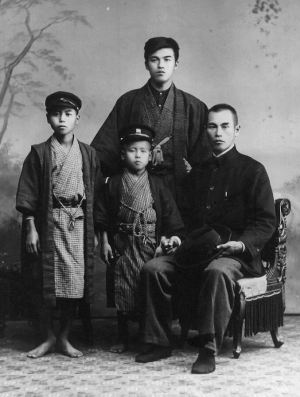
Kentsu with his three oldest sons in Meiji 39, or 1906. The standing youth is 18-year old Kenden. On the left is Kenyu, who later shortened his name to Ken, and on the right is Kenshin. Courtesy the Yabe/Yasui Family Collection.
Because he was a volunteer, the Japanese Army sent Yabu to a school for prospective noncommissioned officers. Upon graduation, he received promotion to sergeant. He was then sent to Manchuria, where he saw service during Japan’s 1894-1895 war with China (Kim, 1974, 64-65; Noble,1988, 32; Yasui, Sep. 6, 1998).
Before getting out of the army, Yabu received promotion to lieutenant. Apparently, he was the first Okinawan to do so in the modern Japanese army, and there is a story that his uniform and sword were subsequently kept in Shuri Castle (Kim, 1974, 64-65; Noble, 1988, 32; Yasui, Sep. 6, 1998). Although there is no reason to doubt the story, it is not verified in documents available to the family. And, no matter what his final rank, Yabu’s subsequent karate students usually called him gunso, meaning "sergeant," rather than chusa, meaning "lieutenant."
I am unaware of any further documented information concerning Yabu’s
military career. However, at speculative levels, Richard Kim wrote that
Yabu perfected his karate on the battlefield against the Chinese (Kim,
1974, 64-65). George Alexander added that "Yabu fought over sixty lethal
karate
duels and was never defeated" (Alexander, 1991, 64). Such accounts are
probably folklore. However, on a more plausible level, Graham Noble has
cited hearsay evidence to the effect that one of Yabu’s military subordinates
died after being struck by Yabu. According to this story, Yabu told investigators
that he struck the man with his open palm (which was legal under Japanese
military law) rather than with his fist (which was illegal). [EN2]
The court accepted his statement after seeing him breaking some boards
with his fist, and consequently, the manslaughter charge was dropped (Noble,
1988, 32). However, I am reluctant to cite even this story as fact without
seeing further evidence.
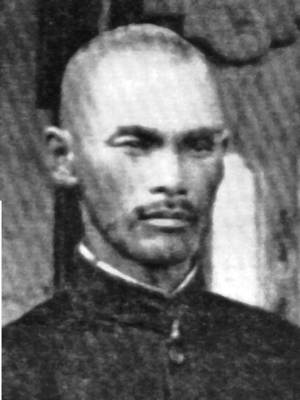
Kentsu Yabu, 1908. He would have been about 42 years of age when
this photo was taken. Courtesy of the Yabe/Yasui Family Collection.
Following his discharge, Yabu returned home to Okinawa. After settling in, he began studying at Shuri’s Prefectural Teachers’ Training College. While there, he frequently helped Ankoh Itosu, who was then leading a campaign to have karate made part of the Okinawan public schools’ physical education curriculum, by giving public demonstrations of karate kata, or practice forms.
Yabu’s favorite kata was reportedly gojushiho. Apparently based on older Chinese forms, gojushiho ("54") was modified during the nineteenth century by Sokon Matsumura. Matsumura’s version of the kata was perhaps influenced by classical Ryukyuan dance, and there is no doubt that it emphasizes open-handed palm-heel and finger strikes (Noble, 1988, 32-33). [EN3] Nonetheless, Dave Lowry writes that Yabu’s version of gojushiho was nothing at all like a dance. Instead, it was "more like the motion of the surf, soft, soft, soft, as it comes in, then smash -- hard like a rock" (Lowry, 1985, 12).
In 1902, Yabu became a karate instructor at Shuri’s Prefectural Number
One School (Hokama, 1998, 88). Former students recalled that his instruction
stressed endless repetitions of naihanchi kata. Toward that end,
Yabu liked to say that students should do 10,000 kata a year (Noble, 1988,
33). The statement may have been hyperbolic, as in Japanese, when one says
"ten thousand," one is not necessarily being literal. On the other hand,
if he was being literal, then he evidently didn’t expect students to know
lots of different kata. After all, to do naihanchi 10,000 times
a year, one must perform at least 28 repetitions per day. In either case,
however, the statement gives an idea of the level of dedication that Yabu
expected from his karate students.
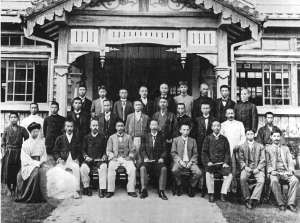
A photo taken in Meiji 41, or 1908, in which Kentsu Yabu appears
third from the right in the back row. The location may be the school where
Yabu received his training as a teacher. If so, then the building would
have been part of the Prefectural Teachers’ Training College, where Ankoh
Itosu taught karate from 1905. However, as this has not been verified,
an alternative is the Prefectural Number One School where Yabu worked as
a teacher. The original photograph belonged to a man named Tetsushijo Nakahara,
and it is presently in the collection of Ryukyu University history professor
Teruo Hiyane. Miyuki Yabe Yasui got her copy from her cousin Ikeda Yabu
Yohko while visiting Shuri in 1993. Courtesy of the Yabe/Yasui Family Collection.
Shotokai karate teacher Mitsusuke Harada has speculated that modern karate’s tendency toward doing things "by the numbers" may be attributable to Yabu, and his military background (Noble, 1988, 33). However, because Japanese scholars have since shown that all Japanese athletic training was heavily militarized during the 1930s and 1940s, that is probably exaggerating things a bit (Abe, Kiyohara, and Nakajima, 1990, 27-43).
During his life, Yabu’s peers frequently honored him. For example, during the mid-1910s, he received the gift of a sword from Toki Higa, who had received the weapon from the Chinese leader Sun Yat-sen (History of the Okinawans in North America, 1988, 12-14). [EN4] In 1924, Yabu was asked to become a charter member of the Okinawa Tode Research Club, an organization dedicated to protecting and preserving tode, as Ryukyuans then called karate (Bishop, 1989, 153). Finally, in 1936, he was asked to join the council of distinguished karate teachers that ultimately agreed to change the name of karate from its traditional characters (kanji) meaning "Chinese hands" into its modern characters meaning "empty hands" (Funakoshi, 1973, 3-4; Funakoshi, 1988, 24-25; Hokama, 1998, 36, 93). [EN5]
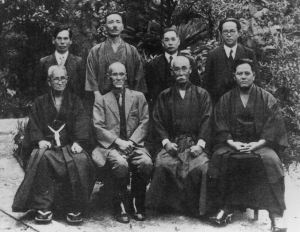
Eight of the men who agreed to change the name of karate to its
modern characters, October 25, 1936. Back row, left to right: Shinpan Shiroma,
Tsuyoshi Chitose, Chosin Chibana, Genwa Nakasone. Front row, left to right:
Chotoku
Kyan, Kentsu Yabu, Chomo Hanashiro, Chojun Miyagi. The first known
publication of this photo was in Karate-do Taikan (1938). Courtesy
Graham Noble.
Both George Alexander and Richard Kim have written that Yabu once defeated the famous karate fighter Choki Motobu during a private contest held at Motobu’s Okinawan estate (Alexander, 1991, 64; Kim, 1974, 64-65). Kim wrote that during their battle, "The air cracked with the sound of loud kiai, feet shuffling, punches and kicks landing on human flesh, and the excited gasps of the few privileged viewers" (Kim, 1974, 64-65). [EN6] Less breathless researchers, however, have been unable to find evidence proving that the two men ever fought, let alone found such vivid contemporary descriptions of their contest (Noble, 2000; Silvan, 1998, 93).
Dave Lowry has therefore speculated that the contest between Motobu and Yabu was not in karate, but in tegumi, or Ryukyuan sumo (Lowry, 1985, 13). That sounds plausible, especially since Yabu went out of his way to organize tegumi matches during the Okinawan celebrations held near Fresno in July 1921 and August 1922. [EN7] Says the History of Okinawans in North America (1988, 339):
Yabu’s son Kenden emigrated to Hawai’i around 1908. After four years there, Kenden went to California. His "Certificate of Fact of Issue of a Passport" signed by the Japanese consul in Los Angeles in 1912 says that his purpose for going to California was to study Western theology. However, in Hawai’i he worked as an agricultural worker, while in California he worked as a gardener. Because of these working-class experiences, Kenden eventually became more interested in socialism than theology (Yabu, 1986, 99; Yasui, Sep.6, 1998; Yasui, Dec. 12, 1998).

Kentsu Yabu with his son Kenden and daughter-in-law Mitsuye. The photo was probably taken in 1921-1922, when Mitsuye was pregnant with eldest daughter Emi. Courtesy of the Yabe/Yasui Family Collection.
In 1919, Kenden married a Japanese woman named Mitsuye Jyoko, and by 1921, she was pregnant with the couple’s first child. The family therefore believes that Kentsu went to California in hopes that his eldest son would give him a grandson. Writes Kenden’s son-in-law Homer Yasui (Sep. 6, 1998):
The story goes that it was Kentsu’s intention – if the child was a boy – to take him back to Shuri to raise in a proper Okinawan fashion. Japanese fathers in those days were very powerful, so it wouldn’t have been a bit surprising if Kenden and Mitsuye would have allowed that. Even in my generation, our fathers were powerful, and the chonans quite a bit less so, but still powerful nevertheless. Anyway, since Miki turned out to be yet another girl, Grandpa Kentsu returned home, probably disgusted, and certainly empty-handed.
On his way back to Okinawa in 1927, Kentsu Yabu SPENT almost nine months
in the Territory of Hawaii. During his stay, Yabu gave two public exhibitions
at the Nuuanu YMCA, then located at Fourth and Vineyard in Honolulu. [EN10]
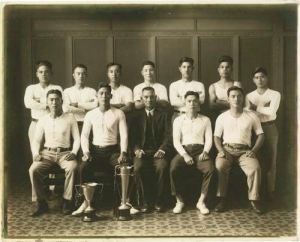
Yabu in Hawaii, 1927. Courtesy Charles Goodin.
Yabu’s exhibition in March was essentially a lecture for a luncheon club. However, his exhibition on Friday, July 8, was a major production, and the guests included a Waseda University baseball team, US military and naval officers, and sportswriters (Nippu Jiji, July 6, 1927). Afterwards, the sportswriter for the Honolulu Advertiser wrote (July 9, 1927):
Lieutenant Yabe stated that boxing was being introduced into Japan but he doubted if it would ever be as popular or used as universally as karate. Legs as well as arms are brought into play.
The various holds and poses of karate were shown and described as follows: Kusanku, Gojushiho, Naihanchi, Sanchin, preparatory drill, Pinan… Passai, etc.
The talk and drill were highly pleasing and instructive. The big crowd appeared to be duly impressed with the possibilities of this sport.
During 1927, Yabu also traveled to Kauai and Maui. "Although we digress
a bit," says the History of the Okinawans in North America, "Yabe
learned a great deal about samisen (the stringed musical instrument)
and the performing arts in Hawai’i from one of his students there, Ryokin
Nakama" (History of the Okinawans in North America, 1988, 341).
The connection to musical instruments becomes clear when you realize that
Yabu financed his trip by taking orders for Ryukyuan artifacts such as
musical instruments, and then mailing them to Hawai’i upon his return to
Okinawa (Personal communication with Charles Goodin, Apr. 9, 1999).
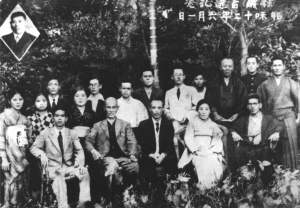
Kentsu Yabu with family and friends, mid-1930s. The original photo
is in the collection of Yabu’s grandson Kenjiro; this copy is courtesy
Patrick McCarthy.
During 1936, Yabu visited Tokyo. He had terminal tuberculosis, so I wouldn’t be surprised to learn that he was visiting physicians. Anyway, while there, Yabu watched the young Shoshin Nagamine practicing karate. Apparently, Yabu warned Nagamine that karate’s kata were undergoing rapid change in Japan. Therefore, it was up to Nagamine and other young men of his generation to preserve the Okinawan kata in their traditional forms (Bishop, 1989, 86).
The following year, Yabu died. Although the ancestral home was destroyed
during the fighting in 1945, second son Ken Yabu rebuilt the house after
the war, and his widow Emi lives there to this day.
Abe, Ikuo, Kiyohara,Yasuharu, and Nakajima, Ken (1990). "Sport and physical education under fascistization in Japan," Bulletin of Health & Sport Sciences, University of Tsukuba, (13): 25-46; reprinted at http://ejmas.com/jalt/jaltart_abe_0600.htm
Adaniya, Ruth, Njus, Alice, and Yamate, Margaret, editors (1988). Of Andagi and Sanshin: Okinawan Culture in Hawai’i. Honolulu: Hui O Laulima.
Alexander, George W. (1991). Okinawa: Island of Karate. Lake Worth, FL: Yamazato Publications.
Bishop, Mark (1989). Okinawan Karate: Teachers, Styles and Secret Techniques. London: A. & C. Black.
Chang, Iris. The Rape of Nanking: The Forgotten Holocaust of World War II (New York: BasicBooks, 1997).
Funakoshi, Gichin (1973). Karate-Do Kyohan: The Master Text. Tokyo and New York: Kodansha International.
Funakoshi, Gichin (1988). Karate-Do Nyumon: The Master Introductory Text. Tokyo and New York: Kodansha International.
Goodin, Charles. (2003). "Hawaii Karate Seinenkai Salutes Kentsu Yabu 1866-1937," http://seinenkai.com/salute-yabu.html
Goodin, Charles. Personal communication, Apr. 9, 1999; see also Steve Lum, "Wanted: Hawaii Karate ‘Pioneers’," Hawaii Herald, Apr. 2, 1999, A-13.
Haines, Bruce A. (1968). Karate’s History and Traditions. Rutland and Tokyo: Charles E. Tuttle.
History of the Okinawans in North America, translation of Hokubei Okinawajin shi, translated by Ben Kobashigawa (1988). Los Angeles: University of California and the Okinawan Club of America.
Hokama, Tetsuhiro. History and Traditions of Okinawan Karate, translated by Cezar Borkowski (1998). Hamilton, Ontario: Masters Publication.
Kim, Richard (no date). "The Sergeant," Karate Illustrated, page unknown. (Xerographic copy courtesy Graham Noble); reprinted at http://www.martialartsca.com/kim.html
Kim, Richard (1974). The Weaponless Warriors. Burbank, California: Ohara Publications.
Lowry, Dave (1985). "Yabu Kentsu, An Okinawan Karateman," Karate Illustrated, (7): 10-13.
McCarthy, Patrick (1995). Bubishi: The Bible of Karate. Rutland and Tokyo: Charles E. Tuttle.
McCarthy, Patrick (1987). Classical Kata of Okinawan Karate. Burbank, California: Ohara Publications.
McCarthy, Patrick (1994). "The Sapposhi, Pechin, and Samurai," The Ryukyuanist 24 (Spring), 1-3; reprinted at http://www.geocities.com/keikoden/McCarthy.htm
Noble, Graham (11/98). Letter to the author.
Noble, Graham, with McLaren, Ian and Karasawa, N. (1988). "Masters of the Shorin-ryu, Part II," Fighting Arts International, 51 (9:3), 32-35; reprinted at http://seinenkai.com/articles/noble/noble-shorin2.html
Noble, Graham (2000). "Master Choki Motobu," Journal of Combative Sport, http://ejmas.com/jcs/jcsart_noble1_0200.htm.
Sakamaki, Shunzo, editor (1964). Ryukyuan Names: Monographs on and Lists of Personal and Place Names in the Ryukyus. Honolulu: East-West Center Press.
Silvan, Jim (1998). "Oral Traditions of Okinawan Karate," Journal of Asian Martial Arts, 7 (3): 72-95.
Yabu, Kenjiro (May 31, 1986). "Genealogy of the Surname So Family (from Kengi the Founder): The Okushima Family Line, An Annotated Text," translated with supplementary notes by Ben Kobashigawa and Yoko Fukumura. Both the Japanese original and the English translation are privately published documents. The Japanese original is in the Yabu Family Collection while the English translation is in the Yabe/Yasui Family Collection.
Yasui, Homer (Sep. 6, 1998). Letter to the author.
Yasui, Homer (Oct. 6, 1998). Letter to the author.
Yasui, Homer (Nov. 7, 1998). Letter to the author.
Yasui, Homer (Dec. 12, 1998). Letter to the author.
EN1. "From early times until fairly recently, " wrote the Hawaiian scholar Shunzo Sakamaki (1964, 13), "every [Ryukyuan] child was given a domyo (or warabe-na) -- literally, his ’childhood name’. For a long time, it was generally his only name throughout his lifetime, since most members of the upper classes did not have surnames and formal names (nanori) until after 1689, and commoners did not have surnames until the 1870s." In general, the oldest son took the same domyo as the paternal grandfather while younger sons took the names of relatives or friends. Although there were probably no more than fifty individual domyo, suffixes such as "Big " and "Little" distinguished between grandfather and grandson, while differences in pronunciation distinguished between aristocrats and commoners.
EN2. Until 1945, the Japanese military encouraged its commissioned and noncommissioned officers to use corporal discipline as a form of what would today be called "tough love." Indeed, the usual euphemism for the practice was bentatsu, or "act of love." For an introduction to the topic, see Chang, 1997, 217.
EN3. The source for this statement was a French translation of an interview between Shinken Gima and Ryuzo Fujiwara (Noble, letter dated 11/98).
EN4. Higa, who arrived in San Francisco in 1896, is believed to have been just the second Okinawan to live in the continental United States. (Keizo Kawatsu, who came to California via British Columbia in 1889, was apparently the first.)
EN5. Although the Okinawan karate teacher Chomo Hanashiro proposed the new name as early as 1905, he was referring to self-defense rather than anything spiritual. In addition, the new name was not formally adopted until October 1936. The fact that Japan was then at war in China undoubtedly had something to do with the timing of the name change.
EN6. Literally "a blending of vital energy," the word kiai properly refers to a manifestation of inner harmonics and discords transmitted directly from the hara, or psychic and physical center of the body. In a classic short story called "The Shout", the English writer Robert Graves once wrote of an audible expression of such energy, "My shout is not a matter of tone or vibration but something not to be explained. It is a shout of pure [energy], and there is no fixed place for it on the scale." In North American and Japanese karate classes, however, the word is more narrowly defined, and usually used to describe the noise that the athlete makes while executing a technique.
EN7. In Okinawan sumo, officials restarted bouts whenever one of the players was thrown to his stomach or knees. Also, judges only counted falls to the back. A typical outdoor tournament started about 10:30 a.m. and continued until dark. To give everyone a better chance of winning, American competitors were sometimes divided by age and weight. If so, then divisions were usually 150 pounds and over, 130-149 pounds, and 129 pounds and under. Hawaiian blue laws, by the way, required players to wear a pair of shorts under their wrestling belts. For further details, see Kenji Yamashiro, "Sumo, Okinawan Style," in Adaniya, et al., 1988, 37-38, and "Okinawan Sumo," Okinawa Times, 1999, http://www.okinawatimes.co.jp/eng/ryukyu/ryu4_10.html.
EN8. Yabe is the Japanese pronunciation of the two Chinese characters pronounced Yabu in the Shuri dialect of the Ryukyuan language. The change in pronunciation and transliteration was sometimes made unilaterally by individuals (to include Yabu’s son Kenden in 1910); it was also made officially by the Education Society of Okinawa in 1937. However, the changes "in the reading of surnames were more effective in overseas areas than in Japan proper," noted Shuncho Higa (in "On Okinawan Surnames," in Sakamaki, 1964, 38). "The reason for this was that in Japan proper, although a person announced a change in the reading of his name, the written characters were not altered, and other people did not readily accept the changed reading. On the other hand, in overseas areas, names were spelled out in Roman writing and there was immediate acceptance of the pronunciation indicated by the Romanized version."
EN9. In 1910, Kenden Yabu legally changed his name to Kenden Yabe.
EN10. In those days, YMCAs were racially segregated,
and the Nuuanu YMCA was Honolulu’s Asian YMCA. Its history is this. In
1899, Reverend Takie Okumura organized a Honolulu baseball team called
the Excelsiors. A year later, Okumura helped organize a four-team league,
and after that, ethnic involvement in Hawaiian sport became widespread.
Meanwhile, Asian students attended the YMCA’s college at Springfield, Massachusetts,
and joined the YMCA in Tokyo and Shanghai. Thus, in 1911 a clerk at the
Japanese consulate applied for membership to the YMCA at Hotel and Alaska
streets in Honolulu, and this caused significant controversy -- should
an Asian be allowed to join an American YMCA? After months of heated public
debate, the Japanese was finally offered membership, but by then of course
he was unwilling to join. Consequently, in March 1912. B. M. Matsuzawa
of the Tokyo YMCA came to Honolulu for the express purpose of opening a
Hawaiian YMCA that would cater to Asians. In September 1912, a Missouri
missionary named Lloyd Killam joined Matsuzawa, and between them, they
began offering English and Japanese-language Bible classes in a room at
the Central YMCA. During a sabbatical to the Midwest in 1915, Killam convinced
several friends to join him in Honolulu, and in 1916, these missionaries
began campaigning for an interracial YMCA in the Islands. The existing
(white) leadership of the Hawaiian YMCA opposed this, so in March 1917,
the missionaries set about raising money for a dedicated Asian facility.
Gifts and public subscription soon raised the necessary funds, and the
Nuuanu YMCA’s first meeting rooms opened in April 1918. During the dedication,
600 Japanese sailors were marched into a membership luncheon for the Korean
members. "When the eight Koreans sat calmly and enjoyed their lunch meeting
and did not throw a sugar bowl or a dish at one of the naval men," said
Killam afterwards, "I knew that the inter-racial plan would be a success."
Over the next five years, membership grew, and so did the facilities. The
large gymnasium, for example, dated to 1922, while the swimming pool opened
in 1924. So, by April 1937, as Killam proudly noted in articles published
in the Nippu Jiji, there were 119 boys’ clubs affiliated with the
Nuuanu YMCA, and 2,766 young men using the facility on a regular basis.